Idli Recipe (Idli Batter Recipe with Pro Tips)
Updated: February 5, 2023, By Swasthi
Idli Recipe, Learn how to make soft Idli Batter using rice or rava. Making soft and fluffiest Idlis at home is really an art which you can easily master with my step by step recipe guide. In this post I share 2 ways to make healthiest and softest Idli at home. The first one is using rice and the other is using idly rava, which is also known as rice rava in some parts of the world. Both the methods will give you soft idlis.
Making Idli using rava is a breeze, we don’t need to grind the rice to make the batter. The texture of the idly made using rava also turn out very soft and nice.
About Idli
Idli is a soft & fluffy steamed cake made with fermented rice & lentil batter. These are one of the healthiest protein packed Breakfasts from South Indian cuisine. They are easily digestible as the rice & lentils known as DAL are soaked, ground, fermented & then prepared by steaming the batter. These are served with a chutney and or with a tiffin sambar.
Is idli healthy? Idli is considered to be the healthiest food due to the unique method of preparation which enhances the bioavailability of the nutrients in urad dal and rice. Soaking the lentils, blending to batter and fermenting enhances the nutrients and they are still preserved as the batter is steam cooked for a short time.
Table of contents
This is what makes idly suitable to all including babies to people on diet and even to the aged, who generally have poor digestion.
If you are wondering what is idli made of ? Idli is made with urad dal ( skinned black gram) and rice. Urad dal is high in protein and calcium. It is absorbed by the body better in the form of idly as it is made from soaked & fermented batter.
How to make healthy idli? Restaurants & Hotels use a ratio of almost 1:4 (dal : rava or rice, as rice is cheaper & more profitable for them). So I suppose we must favor more dal as it is high in protein and less rice or rava specially for home cooking. Since the cost doesn’t matter for home cooked foods as long as they are healthy, tasty and nutritious.
My Idli Recipe
This Idli Recipe does not need too much of rice or rava, yet you can make super white, soft, light and fluffy idlis every time.
When it comes to fermenting, dal contributes more towards the fermentation rather than the rice. So using lesser rava or rice too you can make super soft idly. To make them healthier use lesser rice and more dal.
My Idli Recipe doesn’t call for using cooked rice. So it is the same traditional recipe which has been followed for generations in South India – to soak the grains, blend, and then ferment the batter. Lastly steam cook for health benefits.
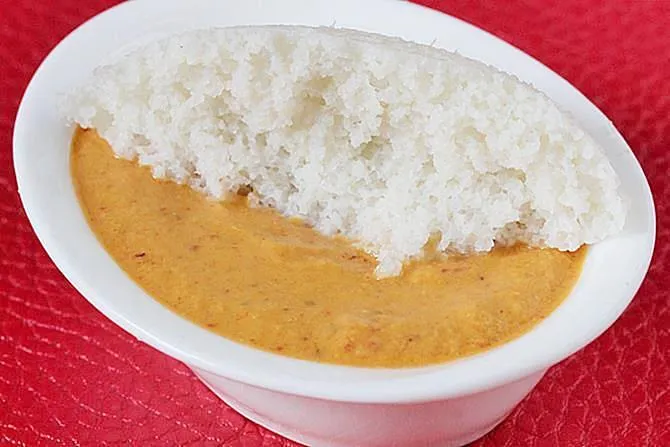
Process of Making Idli Batter
There are 2 ways idli batter can be made
1. The first method uses idli rava which is made of a special kind of parboiled rice. This method is very popular in the south Indian states where the idli rava is available. Making idlis using this method is super quick as the rice need not be ground.
2. The second method is a traditional one which uses idli rice or parboiled rice. However they can be made with most kinds of rice including sona masuri, ponni or parmal rice.
How is Idli Batter Ground?
Traditionally idli batter was ground in a stone mortar pestle to make the urad dal batter very light and fluffy. This light fluffy batter is the key to soft, fluffy and pillowy idlis.
In the current days, it is made either in a wet grinder or blender. Wet grinder works as good as a stone mortar in grinding the urad dal to a smooth and fluffy texture. If it is made in wet grinder then ingredients like poha or methi seeds can be skipped.
Most people prefer making batter in a blender as it is easy to handle. If the batter is made in blender then poha or methi seeds will be helpful to make fluffy idlis.
Blender vs Wet Grinder for Batter
As per my experience both yield the same results if good quality dal is used & blended following the correct method. I do have a wet grinder & blender.
I use the wet grinder only when I have guests home from India. During other times I use the regular blender. Making idli batter in wet grinder is good for larger families – like 5 or more. Otherwise it is quite easy to manage with a blender.
4 Important Factors to Make Soft Idli Batter
(Based on my experience), no matter whether you use a wet grinder or a blender.
1. Age of the dal: Urad dal from the current year’s harvest is best suitable to make soft idli. But how do we identify? The current year’s yield will be white in color with no pale yellow shades on it.
While the yield from the previous years, will be pale yellow in color. Or sometimes pale yellow spots on the dal. Using the new dal will surely result in good fermentation.
This gives you super soft idly provided you take care of the other 3 factors. For those who are not accessible to fresh stock, other ingredients like fenugreek seeds or poha are used to aid the fermentation.
2. Non-iodized salt: always use enough non iodized salt, avoid iodized salts since it do not favor the fermentation process.
3. Temperature to ferment batter: Cold climates do not favor fermentation process. So keep your batter in a warm place. If you live in cold countries, use a preheated oven for fermenting it. Or turn on the light in the oven.
You can also use the fermentation or yogurt making option in your oven, electric cooker or Instant pot.
4. Lastly consistency of idli batter (the amount of water to use): For good fermentation, the batter must be of the right consistency. If you make it runny or thin, it will not rise. But the fermentation will be ok, though not perfect. The result will be wet and flat idly.
But again, if your batter is too thick batter, it will not ferment. I understand this as “the organisms need enough moisture for a healthy cultivation”. So blending it to a right consistency is important. So the soft idli batter must be of a thick but pouring consistency.
Tips to Ferment Batter
Temperature: Warm temperatures between 25 to 32 C (80 to 90F) are ideal for fermentation & it takes about 8 to 12 hours. A higher temperature is just fine and will ferment the idli batter much faster. So you need to watch and move it to the refrigerator once it doubles & before it turns too sour.
Soaking time: Batter won’t ferment quickly at lower temperatures. So basically you need to play with the soaking and fermentation times to check what works during winter and summers. Longer soaking time helps in activation of wild yeast. So soak the rice and dal for longer during cold days.
Dechlorinated water: Avoid chlorinated water to soak and even to blend. Chlorinated water kills the yeast and hinders fermentation process. So use dechlorinated water. Use google search to find ways to dechlorinate water easily.
Fermentation During Winters
Avoid over rinsing soaked rice and dal as it removes the wild yeast completely. We need this wild yeast to assist fermentation.
For better fermentation use the same water in which you soaked your urad dal. But avoid during summer as it leaves a wired & sour smell in the batter.
Speaking of the idli dosa batter, when to add salt – before fermentation or after fermentation is one of the most debated topic. So try and check out what works for you. I add salt before fermentation throughout the year. My mom always adds powdered rock salt after fermentation during summers and before fermentation during winters.
What kind of salt to use? Avoid using table salt or any salt that has added iodine and anticaking agents as they both hinder the fermentation. You can use sea salt, rock salt or pink Himalayan salt that do not have any anticaking agents added to them.
Create a warm atmosphere for the batter
If using microwave convection oven, use your yogurt settings. You can also use Instant pot with the yogurt settings ON (low). I have more details below.
For OTG, Preheat the oven to lowest such as 60 to 80 C or 140 to 175F for 10 mins. Wait for 5 to 7 mins so the temperature comes down a bit. Then place the idli batter inside.
Avoid keeping batter in a very hot oven, this will kill the existing yeast in the batter and won’t ferment. For regular traditional/gas oven, turn on the light.
You may like other South Indian recipes,
Dosa
Masala dosa
Upma
Uttapam
Paniyaram
Photo Guide
How to Make Soft Idli (Stepwise Photos)
1. Prepare the following:
- Add ½ cup dal to a bowl and wash few times until water is clear. Pour fresh water and soak for about 6 hours
- If using fenugreek seeds, soak ½ tsp teaspoon seeds with dal. or soak 2 tablespoons poha, 30 mins before blending.
- Add 1 cup idli rice or 1 cup + 2 tablespoons idly rava to another large bowl. Rinse a few times until water runs clear. Drain the water and soak it. If using rava, nicely squeeze the rava and rinse to get rid of the unwanted stuff.
Make Batter
2. After 6 hours, drain off the water from the dal and add it to the blender along with salt. If you live in a hot place, then skip adding salt now and add it after fermentation, just before making idli. Add ½ cup cold water & blend it smooth. Using cold water prevents the blender or grinder from turning hot. If the batter turns up hot, idli may turn hard.
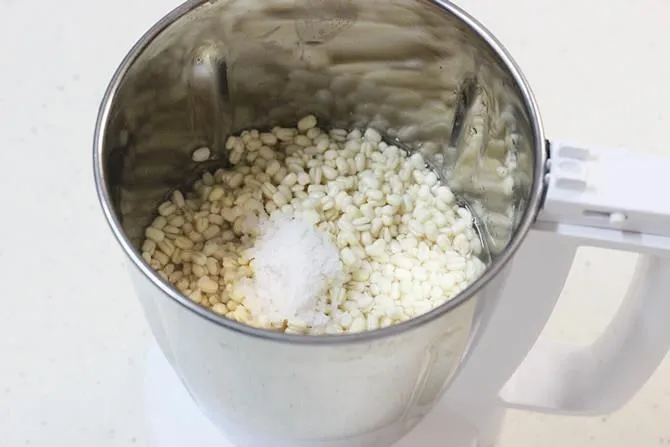
3. Pour 2 to 4 tbsps more water only if needed and blend till you get frothy thick smooth batter. Do not make it very runny.
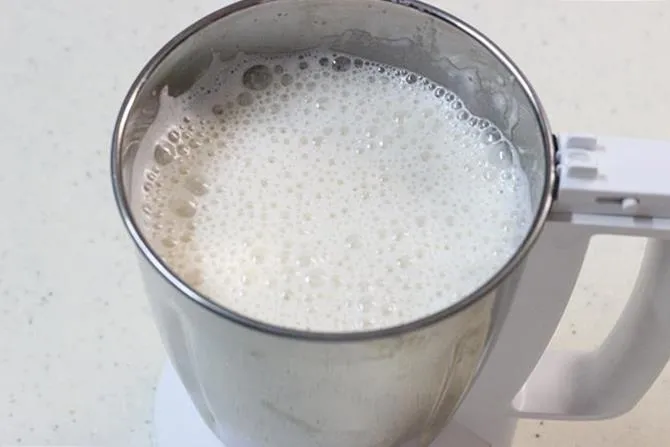
4. Transfer this batter to a large pot or bowl.
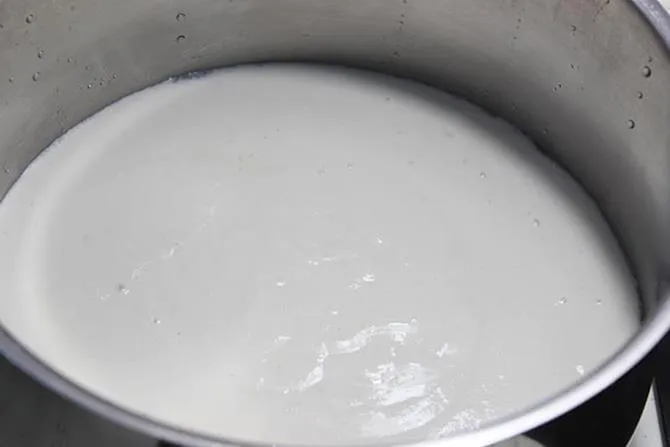
5. If using rice refer method 2 with detailed step by step photos below. A short description is here as well. Add rice and water to the blender and grind coarsely. Pour it to the batter and mix well. Follow from step 6.
If using idly rava: Squeeze off the water by taking rava in between your palms and with pressure try to remove excess water. Transfer this to a plate. Squeeze again any excess water.
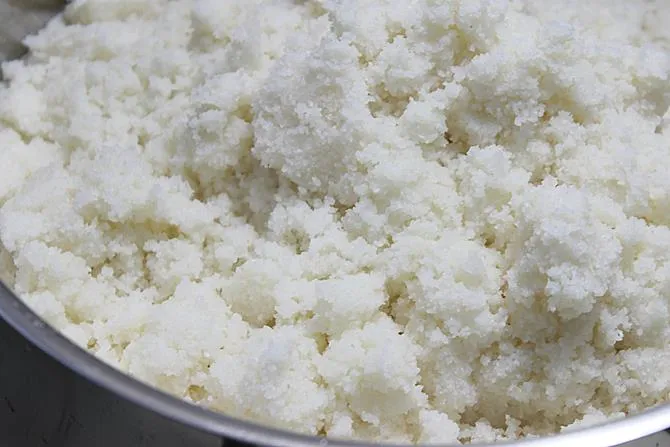
6. Next transfer it to the batter. If you are some one who do not like the slight coarse texture of rava, then you can also blend it well. Then add to the urad batter.
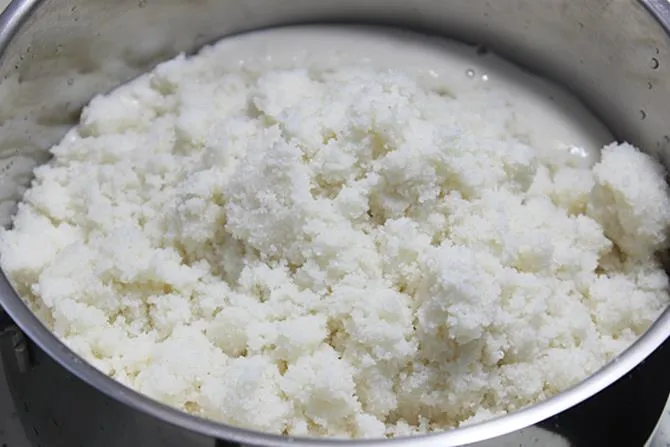
Ferment Idli Batter
7. Mix well with your hands. Keep it aside for fermenting in a warm place for 6 to 12 hours, depending on the climate. It may take up to 18 to 20 hours too sometimes. Do not use air tight jars or containers for fermentation.
If you live in a cold country, you can place it in the oven with the light bulb ON. Or preheat the oven to 120 F or 50 C for 10 to 12 mins. Keep the loosely covered batter bowl inside.
Or If you have a instant pot or microwave (with yogurt function), then you can also turn it ON with the yogurt setting (low) for 6 to 12 hours or until the batter doubles. You have to experiment to know the exact fermentation time.
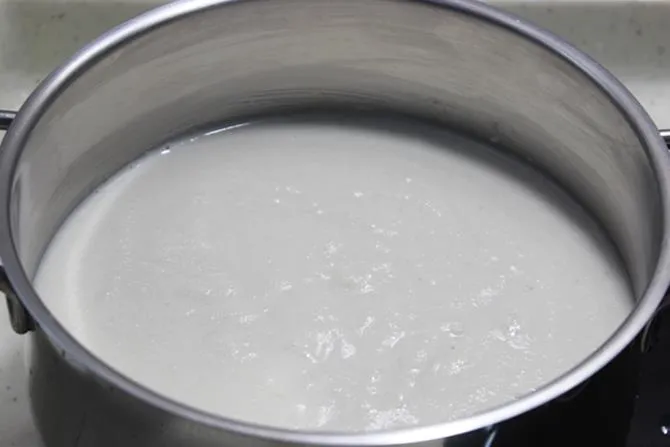
8. After fermentation the batter has to double and turn light, fluffy and bubbly. This time when I made this I had to ferment for about 18 hours as the climate was windy and cold.
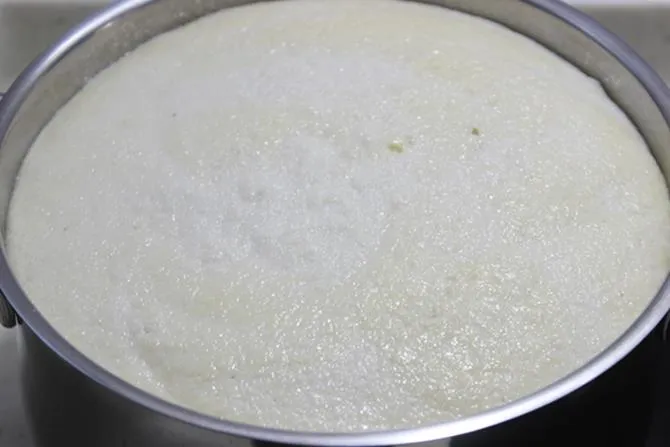
9. Gently mix the batter, very lightly to make it uniform. Sometimes after steaming, idlis will rise and collapse due to the aeration in the batter. So it is ideal to give a gentle stir once. This will also bring the batter to a uniform consistency. I prefer to stir gently only 1 to 2 times. It may shrink when we do this.
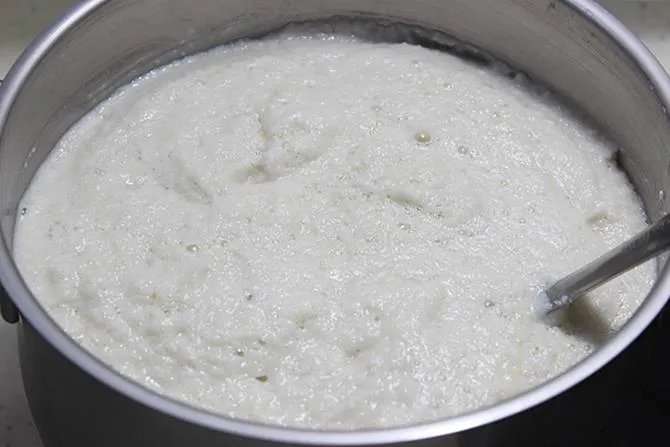
Steam Idlis
10. Bring water to boil in a steamer or pressure cooker without weight on a medium high flame. Grease the idly plates. If needed sprinkle little water. The batter should be of thick pouring consistency. Pour it in the molds.
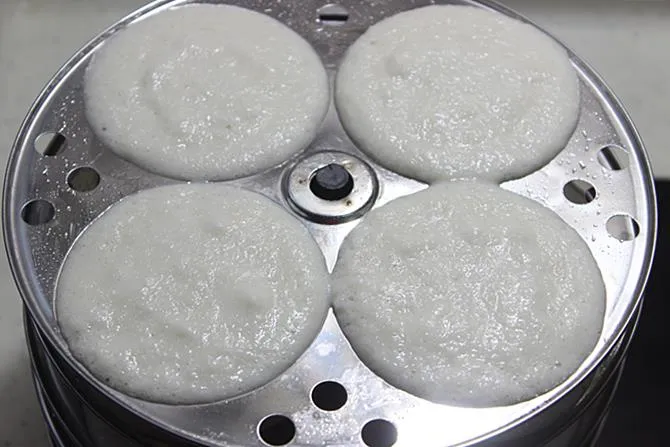
11. When the water begins to bubble up rapidly, place the idly stand in the steamer. Steam it for 10 minutes. Remember you need to be a bit tricky to adjust the flame. If the flame is very high, the water may bounce to the idly plates. If it is to low, they may not get steamed enough. So the flame should be on a medium high. Off the stove after 10 minutes. Leave it for 2 minutes. Remove the plates from the steamer and allow them to cool for 2 to 3 minutes.
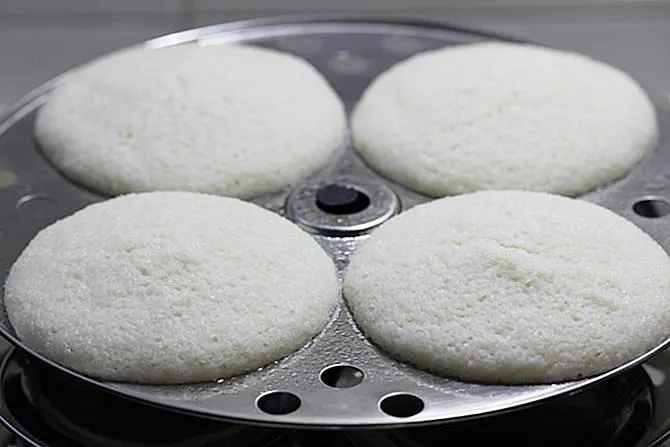
12. Loosen the idli from the plates with the help of a spoon and then remove them to a plate. Add some ghee and serve with coriander coconut chutney or peanut chutney. You can also find a collection of 33 South Indian Style chutney recipes.
What to Serve With Idli?
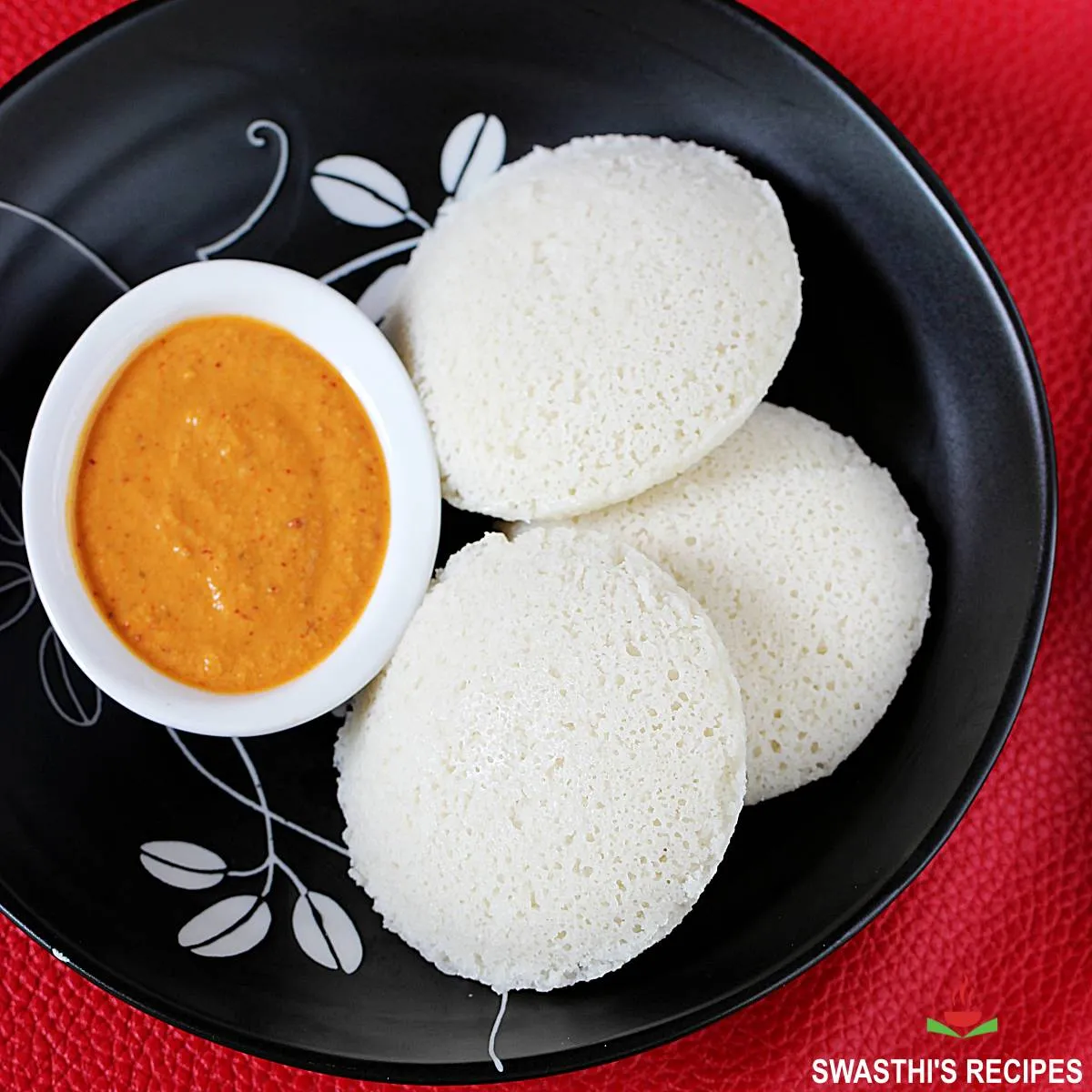
Idly is mostly eaten with a variety of chutneys & a variety of sambar. Here are some popular chutneys that are served
Tomato chutney
Coconut chutney
Pudina chutney
Ginger chutney
We also eat Idli for a meal sometimes, most often it is for dinner. Then I prepare some kind of sambar along with some mini idlis for my kids. Here are some sambar options you may like to check.
Idli sambar or tiffin sambar
Vegetable sambar
Drumstick sambar
Photo Guide
Method 2 – Idli Using Rice
The step by step photos shown below were made with half cup urad dal and 1 cup rice with 2 tbsp poha using recipe 1
1. Blend soaked dal,salt and poha adding water as needed until thick and frothy.
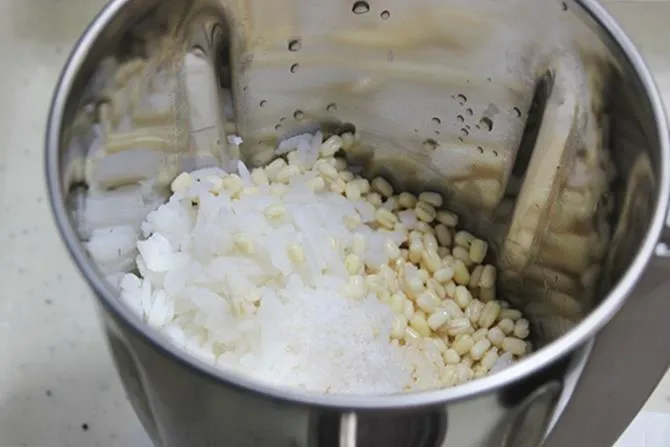
2. Grind rice until smooth or coarse to suit your liking. Add water as needed. Batter must be neither too thick nor too thin.
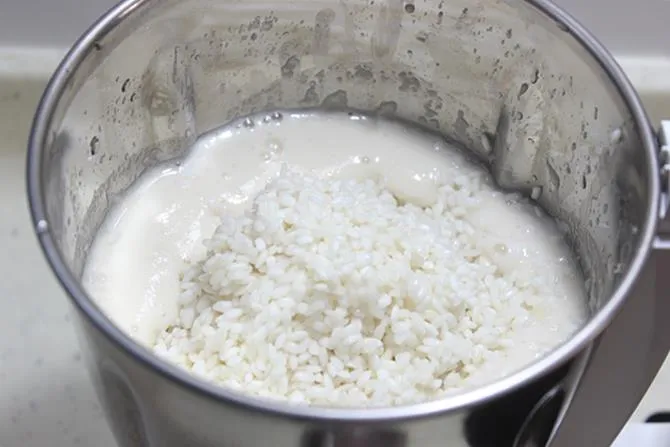
3. Next transfer to a pot. Set aside until fermented. The time it takes depends on the climate. I doubled the recipe 1 and made this. So I had to transfer the idli batter to 2 bowls.
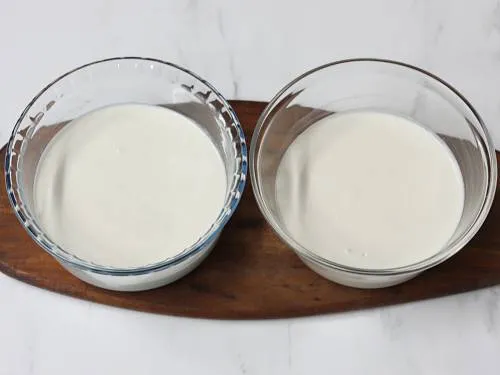
4. After 14 hours, the batter fermented, doubled in volume and had a bubbly texture. Give a gentle stir only twice.
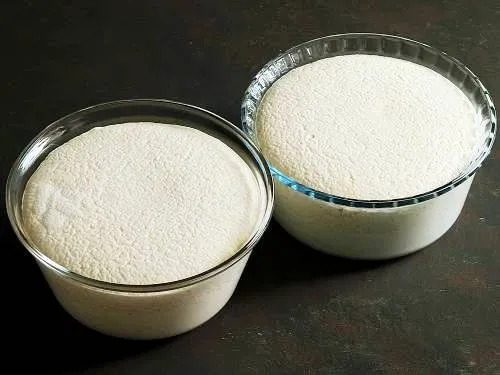
5. Lastly I greased the plates and poured the it in the plates. Steamed for exactly 6 to 7 minutes in the bubbling steamer. Since i made mini idli steamed for just 6 to 7 minutes else they has to be steamed for 10 minutes. Mini idli go well with idli sambar.
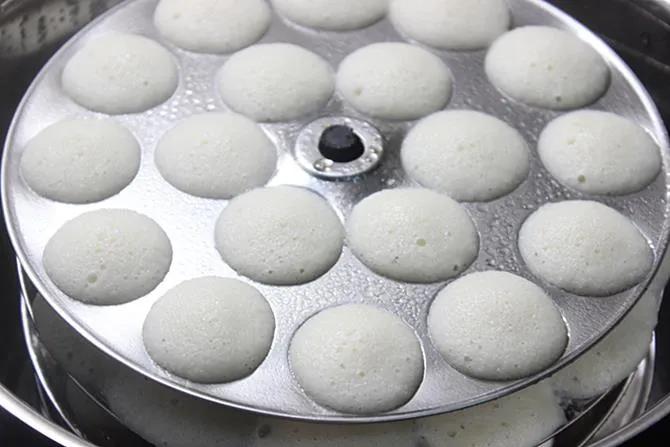
Faqs
Idli rice is the best to make soft idlis. However you may also use parboiled rice or basmati rice. During the lockdown I had made them with different kinds of rice. Aged short grain parboiled rice, raw rice & basmati rice (not parboiled rice) also worked well.
Idli rice is a kind of short grain fat parboiled rice that is cheaper than the regular parboiled rice.
Steam them exactly for 10 minutes on a moderately high flame. I do it on the highest heat. Place the idli stand in the pot only when the water comes to a rolling boil. Cover immediately and then start the 10 mins timer. The timing is the same irrespective of the size of your steaming pot.
They can turn hard if the batter hasn’t fermented well. Make idlis only with well fermented batter that looks well aerated & has risen. Also avoid over cooking them as it makes them hard.
If the batter has fermented partially, then you may wait for few more hours. But if it has not fermented at all even after 18 to 24 hours, then it is good to quit the trial and use it to make dosa, dibba rotti or punugulu. Trying to ferment the batter longer may grow mould over the batter. Read my full post & try it again.
Can You Refrigerate Idli Batter?
Yes. It can be refrigerated for 1 to 2 days. After grinding, it must be transferred to separate containers. Then fermented separately. Next refrigerated after fermentation without disturbing it.
I usually make the idli batter good enough for 2 days. Then transfer it to 2 different containers and ferment them separately.
Use up one the next morning and refrigerate the other as it is without stirring it. For the second day, I use a glass or ceramic bowl. Plastic or steel containers may make it sour. My idli turns out soft with no sour smell even on the subsequent days.
On the third day, I am left with some batter that is not enough for all of us. So I mix up ragi flour in luke warm water and add it to the left over batter. I allow it to rest for 30 mins out of the fridge. Even these turn out good.
How to Make Idli in Instant Pot
For fermentation, place a trivet inside the steel insert of your Instant pot. Then keep the idli batter bowl on the trivet and cover the IP with a plate and not with the lid. Ensure your pot is not too hot from your earlier cooking otherwise your batter will have the flavour of cooked urad dal.
Press the yogurt button (set to low) and the timer to 8 to 16 hours depending on your weather conditions.
To steam the idlis in your IP, pour 1.5 cups water to your steel insert and bring the water to a rolling boil on a saute mode. Meanwhile, fill the idli moulds. When the water begins to boil, place the stand in the IP. Cover it with the lid and position the steam vent to venting mode. Press the steam button and steam them for 10 mins.
Related Recipes
Recipe Card
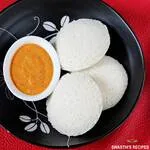
Idli Recipe (Idli Batter Recipe with Pro Tips)
For best results follow the step-by-step photos above the recipe card
Ingredients (US cup = 240ml )
Recipe 1
- ½ cup urad dal or skinned black gram
- 1 cup idli rice (or parboiled rice) or (1x- 1 cup + 2 tbsp idli rava)
- 2 tablespoon thick poha Or ½ tsp fenugreek seeds (methi seeds)
- ½ teaspoon Non-iodized salt (rock salt or pink salt)
- ½ cup chilled water (2 to 4 tbsps more if required, to grind dal)
- ½ cup water (to grind rice)
Recipe 2
- ½ cup urad dal
- 1½ cups idli rice (or parboiled rice)
- ½ teaspoon fenugreek seeds (methi seeds)
- 2 tablespoons thick poha (flattened rice) (substitute with ¼ tsp methi)
- ½ cup chilled water (2 to 4 tbsps more if required, to grind dal)
- ¾ cup water (to grind rice)
Instructions
Preparation
- Add urad dal & methi seeds to a bowl. Add rice or idli rava to another bowl.
- Wash them very well separately until water runs clear. Soak them separately in lot of water for at least 6 hrs.
- Rinse and soak poha with ¼ cup water for about 30 mins before blending.
How to Make Idli Batter
- After 6 hours, drain the water from both the bowls.
- Add dal, methi, soaked poha, salt & water to a blender jar or a wet grinder.
- Blend to a thick, smooth, bubbly & frothy batter. The idli batter should not turn hot or even warm as it makes dense idli. If the batter is too thick you may add 2 to 4 tbsps more water while blending.
- If you live in a hot climate then skip adding salt now and add it just before making idli else the batter turns sour. You will have to experiment with salt to know what works well for you.
- Transfer urad dal batter to a large bowl.
- A. If using rice : Add rice to the blender with water (mentioned in the ingredients). Grind to a little coarse batter (semolina texture). Pour this to the dal batter. Mix both of them well with your clean hands. The batter must be thick yet of pouring consistency. B. If using idli rava : Drain off the water thoroughly from the rava. Squeeze excess water from the rava with the help of both your palms. Rava must not look soggy. It must absolutely have no water in it, else the batter will become runny.
- Transfer this to the urad dal batter and mix well.
- Now mix everything well. Use your hand to mix as it helps to ferment faster and better. If needed can add little water, if the batter is too thick.
Fermenting Idli Batter
- Set the batter aside in a warm place for at least 8 to 14 hrs. The batter ferments and rises well to double the quantity. Sometimes it may take up to 18 hours depending on the weather and temperature.
- If you live in a cold country, keep it in the oven with the light bulb ON. Or preheat the oven to 120 F or 50 C for 10 to 12 mins. Keep the loosely covered batter bowl inside & turn off. If you have a instant pot or microwave (with yogurt function), then you can also turn it ON with the yogurt setting (low) for 6 to 12 hours or until the batter doubles.
- A well fermented batter will yield good soft idli. The batter must rise and look fluffy but not turn sour. You will need to experiment to know the fermentation time.
How to Make Idli
- On a high flame, bring water to a boil in an idly steamer or a pressure cooker. If using instant pot, pour 1½ cups water to your inner pot. Press the saute button and bring the water to a rolling boil.
- Meanwhile grease your idly plates lightly. Mix the idli batter gently 1 to 2 times only. Do not over do as the aerated batter will turn flat. Fill the molds with batter.
- When the water begins to bubble and steam up, place the stand in the steamer. Cover and steam for exactly 10 mins on a high flame. If using Instant pot, when the water begins to boil, press CANCEL button. Keep the idli stand in the IP. Cover with the lid & position the steam release handle to venting . Then press STEAM button. Use an external timer to monitor & steam for 10 to 12 mins.
- Once done turn off and wait for 2 mins. Remove the idly stand. Set aside to cool down for 2 to 3 mins. When cooled, the idli must not be wet on top.
- With the help of a spoon remove the idlis to a plate. Serve idli with a chutney or sambar.
Notes
- Aged urad dal requires lesser water. Fresh dal takes needs more. So adjust the amount of water as required when you blend.
- Nutrition values are for recipe 1
- Do not use air tight jars for fermenting.
- Use stainless steel or ceramic containers for fermenting.
- Avoid plastic jars. Never let your batter warm up while grinding, as it will make the idly harder.
- If using wet grinder, you can use 1½ cups rice for recipe one.
- For Recipe two you can use 2 cups rice.
- Use more water proportionately.
NUTRITION INFO (estimation only)
© Swasthi’s Recipes
About Swasthi
I’m Swasthi Shreekanth, the recipe developer, food photographer & food writer behind Swasthi’s Recipes. My aim is to help you cook great Indian food with my time-tested recipes. After 2 decades of experience in practical Indian cooking I started this blog to help people cook better & more often at home. Whether you are a novice or an experienced cook I am sure Swasthi’s Recipes will assist you to enhance your cooking skills. More about me
Follow Swasthi’s Recipes
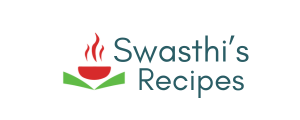
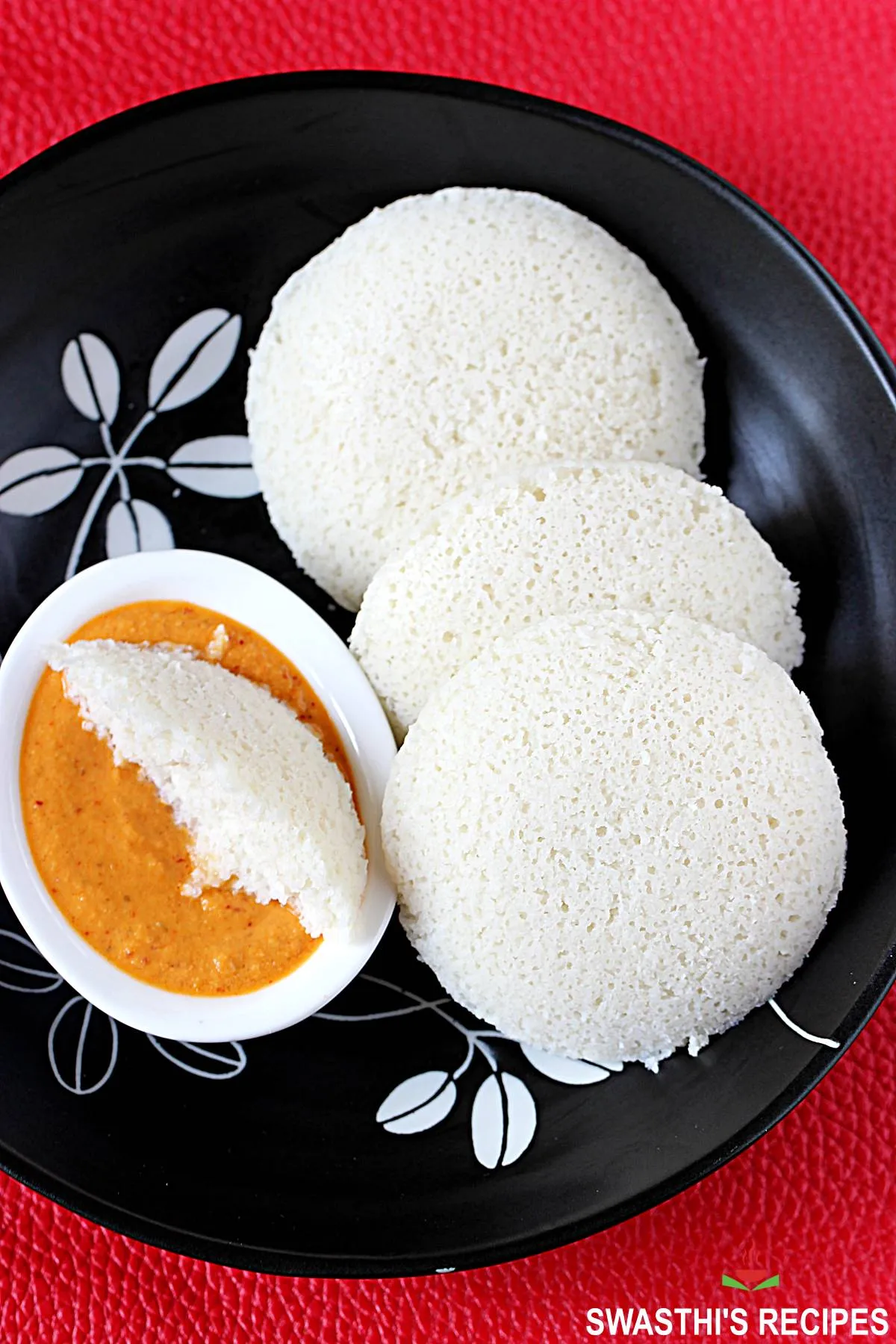
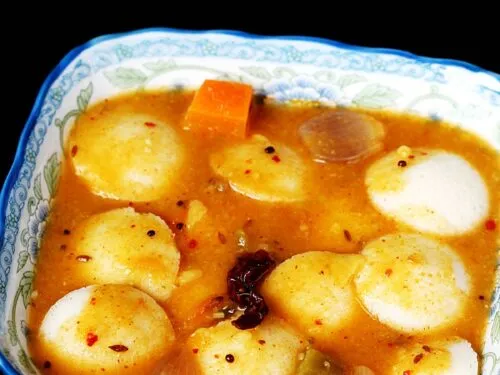
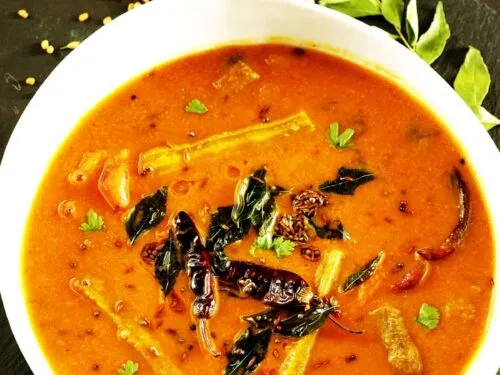
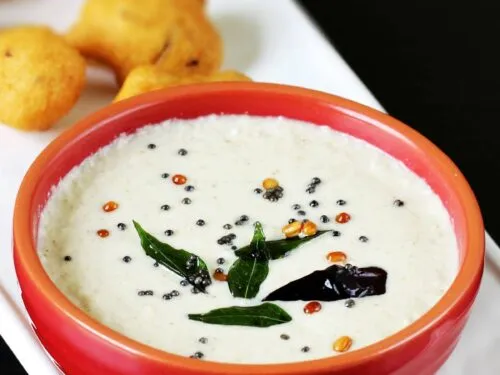
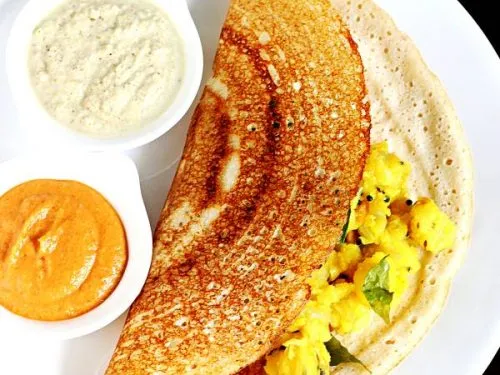
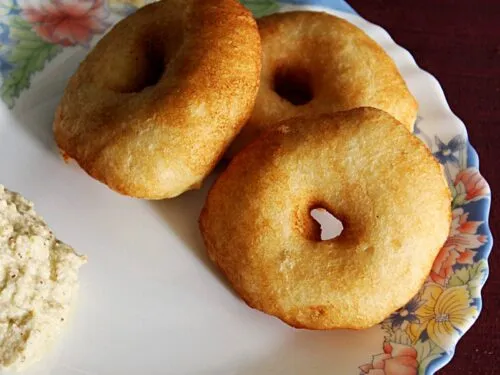
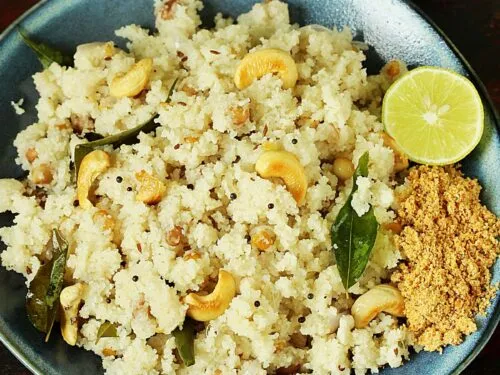
Comments
I’ve been researching on the nutritional values of idli. I love this recipe because it seems to be more nutrient packed with higher amount of protein and lower rice. But how can each idli be 13 g of carb when it is using lesser rice? Please advice
Thanks Malini. Actually the nutritional values can change depending on the size of your idlis. Mine are extra large so the calculation shows higher nutrition values. But you should be able to make 20 to 24 idlis if you are using medium size plates. In that case the carbs will cut down. The nutritional values are calculated by a plugin and can be a rough estimate only. Hope this helps.
Which brand of idli cooker did you use for steaming idlis
Hi Padma,
I use a heavy bottom stainless pot with a vent from WMF and also a large steel pressure cooker (without whistle). The plates were bought separately many years ago in India (may be Bangalore). I don’t know the brand. I don’t use a idli cooker that comes as a set with plates. Hope this helps
Which brand of idli cooker have you used your idlies seem to be very large
Yes the plates are much larger and makes large idlis. To find something like this you should visit shops personally to check the size. Online won’t help. You should mix and match the idli plates and steamer pot or pressure cooker separately, rather than buy the whole set. Hope this helps
Thanks for the fabulous article. I was so excited to try this idli recipe and I got to try it last week. Used my nutribullet and it worked perfectly. Is it essential to soak the lentils and rice separately? Is there any difference to the outcome? Which grinder do you recommend or use?
Glad to know Ivy. Yes it is essential to soak them separately because you want the lentil batter to be very smooth and fluffy but the rice batter to be slightly coarse else your idlis will taste like mashed rice. The outcome is different in texture. Fluffy lentil batter makes fluffy idlis. When you grind them together you won’t achieve the same texture. Currently I’m using Indian grinders like ultra, preeti, panasonic. Other brands like Vitamix or Blendtec also work well. If you don’t make idli often, you can manage with nutribullet. Hope this helps
Thank you for the authentic recipes. Please add a table of contents for navigation.
You are welcome Diti. Yes sure will do that
Your website is my one-stop for everything Indian, from rice, parathas to tikka masala. Everthing I’ve made so far is a huge hit. I have tried your recipe 2 with idli rice twice and have got decent results but fermentation is my biggest problem.
I don’t own an instant pot or a microwave. All I have is an oven that doesn’t have a fermentation or yogurt option. I have tried with the oven light turned on but it took me 15 hours.
The second trial was with a 20 mins preheated oven, left overnight and my batter didn’t rise at all even after 12 hours. So I had to put on the oven light on again and this time it took 8 hours but the batter was sour.
Despite all this, both the times my idli were soft and fluffy but sour. I used poha the first time and the same amount of cooked rice the second time because I was out of methi and poha.
What am I doing wrong and why is my batter not fermenting quickly and turning sour. Thanks for your reply and help.
Thank you so much Arpita. I’m so glad to read that. I highly recommend trying with methi seeds and the next best option is poha, not cooked rice. With cooked rice your idli batter may turn sour or even go bad if it doesn’t ferment under 8 to 9 hours.
Secondly you can try out a combination of the heating/temperature tips I mentioned in the post. Also these will work:
1. Try preheating first and then leave the oven light ON overnight. This works much better if your kitchen is cold. It should be ready under 8 to 9 hrs.
2. If your oven can go as low as 75 to 90 F, it can ferment under 7 to 8 hours even on the coldest day. Set your oven to that temp and leave it overnight.
Slow fermentation for long time or fermenting at high temperature, both can make your batter turn too sour. Hope this helps
Best idli recipe on the internet. So soft, white and fluffy. Thank you for the amazing recipe
Thank you so much Sobha.
As a South Indian, I had no idea Idly could be prepared this way, what a unique twist, I’m gonna try this method soon, thanks for sharing such an interesting info.
Hope you get to try Radha. Thank you
I tried recipe 1 with basmati rice and my idlis were soft. However there was a thin dry layer over the idlis when they cooled down. But they were tasty and good. Please suggest how to avoid the thin dry layer on top.
Hi Subha,
That actually happens with too much starch (like in raw rice). That’s the reason we use parboiled rice to make idli. Rinse the rice very well 3 times before soaking. Repeat the rinse again before grinding. Also using aged rice may prevent this. Newly harvested or fresher stocks of basmati raw rice is not great to make idlis. Try with parboiled/sella basmati instead. Hope this helps
I use moong dal or urad dal or even a mix. It ferments faster and tastes very good.
Adding poha makes these fluffier, better net when they rise.
I also make picnic idlis by including the chutney within the idli in itself. Coconut chutney
Do elaborate on using idli rice vs using rice variety. The time for soak and ferment.
Thanks Ekta for sharing your experience and love those chutney stuffed idlis. I ate them in many restaurants in Bangalore. Yes I will update it
Your recipes are the best and love your work. Being a North Indian, it was very hard for me to make soft fluffy and white idlis. You answered all my questions and today is the third time I made super good idli with coconut chutney. Last time I made your idli sambar too and it was a fabulous meal.
Thank you for the kind words Amandeep. Glad to know the recipe worked for you
I have eaten idli all my life and always made with 1:4 ratio. I was looking to cut down rice and found your recipe. My idli turned out so good and no one noticed there is so little rice. I wish I had seen this recipe earlier. Thank you so much for showing this healthy idli recipe.
Very happy to read this Jayanti. Thank you for letting me know
thanks you explained it very elaborately and clearly. here at my place whole black urad is available and whole white urad not available …. would black one will work ??
yes black urad works. But cleaning the husk is very hard. It takes a minimum of 25 to 30 mins. You should rub the soaked dal very well with both your hands and then fill with water. Drain off the water along with the skin. Do this many times until the dal looks all white.
how to freeze the fermented batter for 3-4 months? any tips?
I wouldn’t suggest freezing so long. 1 month is alright. Transfer to glass containers and freeze
beautifully explained with caution so that you get the best result even the first time round. thankyou for sharing so meticulously.
Kunj
Thank you Kunj
I love is it is amazing
Thanks Nadya
Swathi
I need your guidance…
I used 1/3 urad & 3 times 1/3 idli rice….
My batter was well fermented…
But I didn’t know how much water to add before making the idli..
I used hardly any water when grinding…
Just a little bit
How much water should I use..
Please do guide me…
Hi Sabira,
You won’t need to add any water after fermentation if you use the correct amount while grinding. If you think it is too dry and very thick, then just sprinkle a splash – 1 to 2 tbsps, not more. Give only a gentle stir, don’t overdo else you will have flat idlis. It is ideal to use the correct amount of water while grinding than adding later. So next time, measure the water while grinding. Hope this helps.
Ma’am, your page is such a blessing. You’re a scientist that has an answer to everything culinary. Your page is the first go-to for my wife and myself.
Thank you so much Sandeep for the kind words. So glad the recipes are helping.
Swasthi I just love your recipes. All are perfect to the T. The softest and fluffiest idlis I ever made. Thankyou so much. I share your recipes and recommend your site to all my friends and family. God bless.
Thank you so much for the wishes Peri. So glad you like them!
Thanks! Do you soak the ingredients in the fridge or on the counter?
Laura, Leave them on the counter
I was trying to cut down carbs and eat higher protein while still enjoying my idlis. Your recipe helped me. can’t believe they turned out amazing.